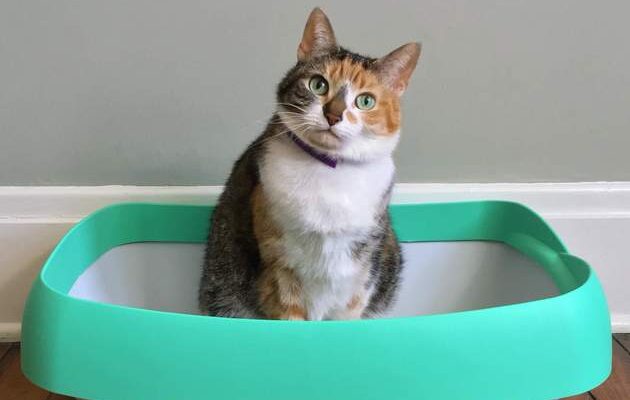Why Do Some Cats Eliminate Outside the Litter Box?
Litter box use problems in cats can be diverse and complex. Behavioral treatments are often effective, but the treatments must be tailored to the cat’s specific problem. Be certain to read the entire article to help you identify your particular cat’s problem and to familiarize yourself with the different resolution approaches to ensure success with your cat.
Litter box Management Problems
If your cat isn’t comfortable with her litter box or can’t easily access it, she probably won’t use it. The following common litter-box problems might cause her to eliminate outside of her box:
- You haven’t cleaned your cat’s litter box often or thoroughly enough.
- You haven’t provided enough litter boxes for your household. Be sure to have a litter box for each of your cats, as well as one extra.
- Your cat’s litter box is too small for her.
- Your cat can’t easily get to her litter box at all times.
- Your cat’s litter box has a hood or liner that makes her uncomfortable.
- The litter in your cat’s box is too deep. Cats usually prefer two to three inches of litter.
- Your cat can’t get into the litterbox easily. Some older and overweight cats have mobility issues that make it difficult to navigate high sided litterboxes.
- The litterbox is in a scary place. Laundry rooms and basements can make some cats nervous, they need areas that aren’t so dark and noisy.
- Your litterboxes are all lined up against a wall. Some cats see this as one big box and need more separation. Placing a box on every level of the home would be preferable.
- She’s not familiar with the litterbox you’ve offered her. If a cat is not accustomed to using an electronic box, it could be scary for her. She’ll need to be desensitized to this box, while also offering her a more traditional box to keep her on track with her litterbox use.
- You’ve recently changed the type of litter that she’s used to, or she’s new to your home and is uncomfortable with the litter that she’s been offered. Unconventional litters like pine and paper litters need to be introduced slowly to your cat as they’re likely not something she’s used to. You can start by slowly adding the new litter to her box until it’s all new litter, but you’ll want to be sure that she’s consistently using the box as you increase the amount of the new litter.
- You’re using a scented litter. Cats prefer a soft, unscented litter over most other litters.
- Your clumping litter clumps so tightly that it’s creating cement-like rocks in the litterbox. These can be painful to step on, making your cat uncomfortable entering the litterbox. You’ll want to either change your litter or make sure that you’re scooping twice a day.
Negative Litterbox Association
There are many reasons why a cat who has reliably used her litter box in the past starts to eliminate outside of the box. One common reason is that something happened to upset her while she was using the litter box. If this is the case with your cat, you might notice that she seems hesitant to return to the box. She may enter the box, but then leave very quickly—sometimes before even using the box. One common cause for this is painful elimination. If your cat had a medical condition that caused her pain when she eliminated, she may have learned to associate the discomfort with using her litter box. Even if your cat’s health has returned to normal, that association may still cause her to avoid her litter box. It’s always important to have your cat seen by a veterinarian at the first sign of litterbox issues, even if you think your cat is healthy.
Household Stress
Stress can cause litterbox problems. Cats can be stressed by events that their owners may not think of as traumatic. Changes in things that even indirectly affect a cat, like moving, adding new animals or family members to your household- even changing your daily routine- can make your cat feel anxious.
Multi-Cat Household Conflict
Sometimes one or more cats in a household control access to litter boxes and prevent the other cats from using them. Even if one of the cats isn’t actually confronting the other cats in the litter box, any conflict between cats in a household can create enough stress to cause litter-box problems.
What to Do If Your Cat Eliminates Outside the Litter Box
Basic Tips for Making Cats Feel Better About Using Their Litter Box
- Virtually all cats like clean litter boxes, so scoop and change your cat’s litter at least once a day. Rinse the litter box out completely with baking soda or unscented soap once a week.
- The majority of cats prefer large boxes that they can enter easily. Plastic sweater storage containers make excellent litter boxes as do cement mixing containers.
- Most cats like a shallow bed of litter. Provide three inches of litter rather than four or five inches.
- Most cats prefer soft clumping, unscented litter.
- Your cat may prefer the type of litter she used as a kitten.
- Most cats don’t like box liners or lids on their boxes.
- Cats like their litter boxes located in a quiet but not “cornered” location. They like to be able to see people or other animals approaching, and they like to have multiple escape routes in case they want to leave their boxes quickly.
Resolving a Litter Box Problem
The first step in resolving elimination outside the litter box is to rule out medical problems. Have your cat checked thoroughly by a veterinarian. Once your veterinarian determines that your cat doesn’t have a medical condition or issue, try following these guidelines:
- Provide enough litter boxes. Make sure you have one for each cat in your household, plus one extra. For example, if you have three cats, you’ll need a minimum of four litter boxes.
- Place litter boxes in accessible locations, away from high-traffic areas and away from areas where the cat might feel trapped. If you live in a multistory residence, you may need to provide a litter box on each level. Keep boxes away from busy, loud or intimidating places, like next to your washer and dryer or next to your dog’s food and water bowls, or in areas where there’s a lot of foot traffic.
- Put your cat’s food bowls somewhere other than right next to her litter box.
- Remove covers and liners from all litter boxes.
- Give your cat a choice of litter types. Cats generally prefer clumping litter with a medium to fine texture. Use unscented litter. Offer different types of litter in boxes placed side-by-side to allow your cat to show you her preference.
- Scoop at least once a day. Once a week, clean all litter boxes with warm water and unscented soap, baking soda or no soap, and completely replace the litter. The problem with scented cleaners is that your cat could develop an aversion to the scent.
- Clean accidents thoroughly with an enzymatic cleanser designed to neutralize pet odors. You can find this kind of cleaner at most pet stores.
- If your cat soils in just a few spots, place litter boxes there. If it’s not possible to put a box in a spot where your cat has eliminated, place her food bowl, water bowl, bed or toys in that area to discourage further elimination.
- Make inappropriate elimination areas less appealing. Try putting regular or motion-activated lights in dark areas. You can also make surfaces less pleasant to stand on by placing upside-down carpet runners, tin foil or double-sided sticky tape in the area where your cat has eliminated in the past.
- If you have a multi cat home, make sure that you’ve got plenty of resources throughout the home. This could mean adding feeding stations and safe spots/ vertical space in addition to adding litterboxes.
- Make sure that you’re cleaning accidents thoroughly with an enzymatic cleanser designed to neutralize pet odors. You can find this kind of cleaner at most pet stores.
If Your Cat Has Developed a Surface or Location Preference
If your cat seems to prefer eliminating on a certain kind of surface or in a certain location, you’ll need to make that surface or its location less appealing. If the preference is in a dark area, try putting a bright light or, even better, a motion-activated light in the area. You can also make surfaces less pleasant to stand on by placing upside-down carpet runners, tin foil or double-sided sticky tape where your cat has eliminated in the past. At the same time, provide your cat with extra litter boxes in acceptable places in case part of her problem is the location of her usual litter box, and be sure to give her multiple kinds of litter to choose from so that she can show you which one she prefers. Put the boxes side-by-side for a while, each with a different type of litter, and check to see which one your cat decides to use.
If Your Cat Has Developed a Litter Preference or Aversion
Cats usually develop a preference for litter type and scent as kittens. Some cats adapt to a change of litter without any problem at all, while other cats may feel uncomfortable using a type of litter that they didn’t use when they were young.
If you think your cat may dislike her litter type, texture or smell, try offering her different types of litter to use. Cats generally prefer clumping litter with a medium to fine texture. They also usually prefer unscented litter. To help your cat pick her preferred litter, put a few boxes side-by-side with different types of litter in them. She’ll use the one the she likes best.
If Your Cat Is Unable to Use Her Litter Box
Special-needs cats such as those who are older, arthritic or still very young might have trouble with certain types of litter boxes. Boxes that have sides that are too high or have a top-side opening might make it difficult for your cat to enter or leave the box. Try switching to a litter box with low sides.
Negative Litter Box Association
If your cat has experienced some kind of frightening or upsetting event while using her litter box, she could associate that event with the litter box and avoid going near it. Things that might upset your cat while she’s eliminating in her box include being cornered or trapped by a dog, cat or person, hearing a loud noise or commotion, or seeing something frightening or startling. These experiences—or any other disturbing experience—could make your cat very reluctant to enter her litter box. If your cat is afraid of her litter box, you may notice her running into the box and then leaving again very quickly, sometimes before she’s finished eliminating. You may also notice her eliminating nearby, but not inside her box. This means that your cat is worried about using her box, especially if she has reliably used litter box in the past. See below for some ideas on how to treat this.
Treatment for Household Stress
Cats sometimes stop using their litter boxes when they feel stressed. Identify and, if possible, eliminate any sources of stress or frustration in your cat’s environment. For instance, keep her food bowls full and in the same place, keep her routine as predictable as possible, prevent the dog from chasing her, close blinds on windows and doors so she isn’t upset by cats outside. If you can’t eliminate sources of stress, try to reduce them. Incorporate the use of Feliway spray or diffusers, which deliver a synthetic pheromone that has been shown to have some effect in relieving stress in cats. You can find Feliway products in many pet stores and online.
Treatment for Multi-Cat Household Conflict
Sometimes an elimination problem can develop as a result of conflict between cats who live together. If you have multiple cats and aren’t sure which cat is soiling, speak with your veterinarian about giving fluorescein, a harmless dye, to one of your cats. Although the dye does not usually stain carpeting, it causes urine to glow blue under ultraviolet light for about 24 hours. If you can’t get or use fluorescein, you can temporarily confine your cats, one at a time, to determine which one is eliminating outside of the litter boxes in your home.
If there is a conflict between your cats and one of them seems stressed, provide additional litter boxes in locations where the anxious cat spends the majority of her time. Also be sure to provide adequate resting areas for each cat. It can very useful in multi-cat households to create vertical resting spots on shelves or window sills or by buying multi-perch cat trees. It may help to distribute resources such as food, water, cat posts or trees, and litter boxes so that each individual cat can make use of them without coming into contact or having a conflict with one of the other cats. Using Feliway spray or diffusers can reduce general social stress in your household.
Medications
Always consult with your veterinarian or a veterinary behaviorist before giving your cat any type of medication for a behavior problem. Medications can provide additional help in treating inappropriate elimination when the behavior is in response to stress or anxiety. If you’d like to explore this option, speak with your veterinarian, a veterinary behaviorist or a Certified Applied Animal Behaviorist who can work closely with your vet.
What Not to Do
Regardless of what you do so solve your cat’s elimination problems, here are a few things to avoid:
- Do not rub your cat’s nose in urine or feces.
- Do not scold your cat and carry or drag her to the litter box.
- Do not confine your cat to a small room with the litter box, for days to weeks or longer, without doing anything else to resolve her elimination problems.
- Do not clean up accidents with an ammonia-based cleanser. Urine contains ammonia, and therefore cleaning with ammonia could attract your cat to the same spot to urinate again. Instead, use a product specifically for cleaning pet accidents, such as Nature’s Miracle.
This information was originally provided at www.aspca.org







